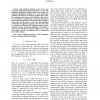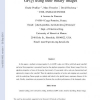76 search results - page 10 / 16 » Random codes: Minimum distances and error exponents |
TIT
2008
13 years 6 months ago
2008
The minimum distance is one of the most important combinatorial characterizations of a code. The maximum likelihood decoding problem is one of the most important algorithmic proble...
TCOM
2008
13 years 5 months ago
2008
In this paper, a method to design regular (2, dc)-LDPC codes over GF(q) with both good waterfall and error floor properties is presented, based on the algebraic properties of thei...
FDTC
2008
Springer
13 years 8 months ago
2008
Springer
The adaptive and active nature of fault based sidechannel attacks along with the large arsenal of fault injection methods complicates the design of effective countermeasures. To o...
ICC
2000
IEEE
13 years 10 months ago
2000
IEEE
Structurally distinct constellation labelings exist within both the Gray code and the set-partitioning paradigm. Different labeling choices within either paradigm can provide diffe...
TWC
2010
13 years 1 months ago
2010
The goal of this paper is to explore the benefits of channel diversity in wireless ad hoc networks. Our model is that of a Poisson point process of transmitters, each with a recei...


